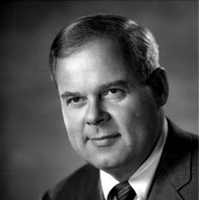John Skilling
John Skilling graduated from the University of Washington in 1947 with a B.S. in civil engineering John started working for the W.H.Witt Co. soon after graduation. In 1983, he became the chairman of the firm. Prominent constructions under his leadership include the World Trade Center, Rainier Bank Tower, the Seafirst Building, Seafirst Fifth Avenue Tower, Century Square, Columbia Seafirst Center and the Washington State Convention and Trade Center.
In 1993 after the 1993 World Trade Center bombing, John Skilling said in an interview to the Seattle Times that according to their studies the World Trade Center was strong enough to withstand the impact of a Boeing 707. The only thing they were worried about was, in case of an airplane crash, the dumping of all air fuel into the building which would cause a horrendous fire. The building structure would still be there. When John eventually took over as head of the firm, it became known as Skilling Ward Magnusson Barkshire. Under John’s leadership, the company was responsible for the structural engineering of more than 1,000 buildings in 36 states and 16 countries, garnering more than 85 awards for excellence in structural design.
John entered the engineering field early when he worked on federal construction projects during the summers with his father, who was a civil engineer. These projects took his family from city to city, eventually bringing them to the Pacific Northwest, where John would later put down roots and raise his own family. After graduating from Kent Senior High School in 1940, John enrolled at the University of Washington.
John was “personally responsible for the structural design of many of the most significant structures in the U.S These structures included more than 75 high-rise buildings (four of the world’s 10 tallest at the time) and more than 40 long-span structures.These engineering innovations plus the original structural design of Seattle’s IBM Building (1964) led to receiving the commission to engineer the quarter-mile-high twin towers of the New York World Trade Center (1972). John and colleague Les Robertson used three studies that were “fi rsts” in the field; a comprehensive wind-environmental study, a boundary-layer wind-tunnel study, and a human-sensitivity-to-building-motion study. The World Trade Center was also the first building to use prefabricated, multiple-column-and-spandrel steel wall panels. And it was the first building to use mechanical damping units to reduce wind excitation. The buildings withstood a bombing attack in 1993 but unfortunately were unable to survive the dual terrorist attack in 2001.
John’s Seafirst Headquarters Building had only four exterior corner columns, but even those four were eliminated for the Rainier Tower (1977). The result is a daring, flared, concrete pedestal that covers only a quarter of the site at ground level allowing for more open views of the surrounding classical buildings. The first rental floor is 12 stories above the ground, providing excellent views and, thus, higher leasing rates. This concept, created by John, is an example of how much responsibility he had for the architectural forms of his buildings.
At 76 stories, John’s Columbia Seafirst Center (1985), still Seattle’s tallest building, was the first in which composite columns were used at the apexes to reduce wind sway in a triangular-braced building. It was also the first time multilayer viscoelastic dampers were attached to the braces of a high-rise building to reduce wind-induced accelerations.
For the Washington State Convention and Trade Center (1988), John conceived of economical, yet creative ways for the building to span 12 lanes of freeway and three city streets. To accomplish this, he used braced, multi chord trusses, which required more than 2,500 different structural-steel connection details.
One of the last projects, John was Seattle’s Two Union Square (1989), at the time, the most economical building of its height ever built. In this building, he pioneered the use of steel tubes filled with a record-breaking high-strength concrete of 20,000 psi as interior columns. Using this technique, which has since become standard in the industry, we were able to provide 10 corner offices on each typical rental floor. By developing hyper-efficient viscoelastic dampers, he reduced the number of necessary dampers to only 16 for the entire 56- story building.
He was awarded the American Institute of Architects (AIA) prestigious Allied Professions Medal, as well as an honorary membership in the AIA Seattle chapter. John was named Engineer of the Year three times—by the Consulting Engineers Council of Washington (now ACEC), by the Structural Engineers Association of Washington, and by the Washington Society of Professional Engineers. John owned 13 patents related to railcar suspension. Seattle Mayor Norm Rice declared June 3, 1994, John Skilling Day.

John Skilling
Date of Birth: 08 Oct 1921
Birth Place: United States
Proffession: civil engineer
Nationality: United States
Death: 5 March 1998, Seattle, Washington, United States


